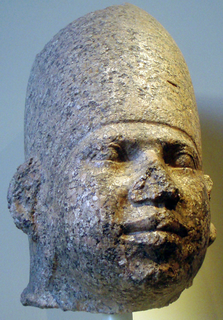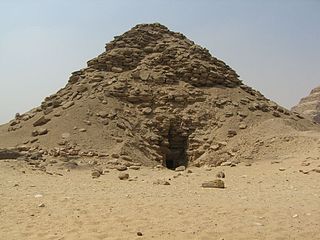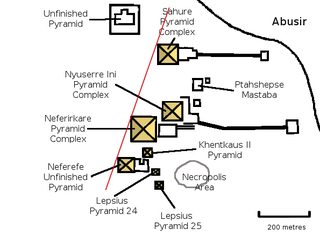
Sahure was an ancient Egyptian pharaoh and second ruler of the Fifth Dynasty. He reigned for about 12 years in the early 25th century BC during the Old Kingdom Period. Sahure's reign is considered to mark the political and cultural high point of the Fifth Dynasty. He was probably the son of his predecessor Userkaf with Queen Neferhetepes II, and was in turn succeeded by his son Neferirkare Kakai.

Abu Gorab is a locality in Egypt situated 15 km (9.3 mi) south of Cairo, between Saqqarah and Al-Jīzah, about 1 km (0.62 mi) north of Abusir, on the edge of the desert plateau on the western bank of the Nile. The locality is best known for the solar temple of King Nyuserre Ini, the largest and best preserved solar temple, as well as the solar temple of Userkaf, both built in the 25th century BCE during the Old Kingdom Period. Evidence suggests that as many as six solar temples were constructed during the 5th Dynasty, however, only the two temples previously mentioned have been excavated. Abu Gorab is also the site of an Early Dynastic burial ground dating back to the First Dynasty.

Huni was an ancient Egyptian king and the last pharaoh of the 3rd dynasty during the Old Kingdom period. Following the Turin king list, he is commonly credited with a reign of 24 years, ending c. 2600 BC.

Userkaf was an Egyptian pharaoh and the founder of the Fifth Dynasty. He reigned for seven to eight years in the early 25th century BC, during the Old Kingdom Period. He probably belonged to a branch of the Fourth Dynasty royal family, although his parentage is uncertain; he could have been the son of queen Khentkaus I. He had at least one daughter and very probably a son with his consort Neferhetepes. This son succeeded him as pharaoh Sahure.

Neferirkare Kakai was an ancient Egyptian pharaoh, the third king of the Fifth Dynasty. Neferirkare, the eldest son of Sahure with his consort Meretnebty, was known as Ranefer A before he came to the throne. He acceded the day after his father's death and reigned for eight to eleven years, sometime in the early to mid-25th century BCE. He was himself very likely succeeded by his eldest son, born of his queen Khentkaus II, the prince Ranefer B who would take the throne as king Neferefre. Neferirkare fathered another pharaoh, Nyuserre Ini, who took the throne after Neferefre's short reign and the brief rule of the poorly known Shepseskare.

Menkauhor Kaiu was an Ancient Egyptian pharaoh of the Old Kingdom period. He was the seventh ruler of the Fifth Dynasty at the end of the 25th century BC or early in the 24th century BC.

Nyuserre Ini was an Ancient Egyptian pharaoh, the sixth ruler of the Fifth Dynasty during the Old Kingdom period. He is credited with a reign of 24 to 35 years depending on the scholar, and likely lived in the second half of the 25th century BCE. Nyuserre was the younger son of Neferirkare Kakai and queen Khentkaus II, and the brother of the short-lived king Neferefre. He may have succeeded his brother directly, as indicated by much later historical sources. Alternatively, Shepseskare may have reigned between the two as advocated by Miroslav Verner, albeit only for a few weeks or months at the most. The relation of Shepseskare with Neferefre and Nyuserre remains highly uncertain. Nyuserre was in turn succeeded by Menkauhor Kaiu, who could have been his nephew and a son of Neferefre.

Abusir is the name given to an Egyptian archaeological locality – specifically, an extensive necropolis of the Old Kingdom period, together with later additions – in the vicinity of the modern capital Cairo. The name is also that of a neighbouring village in the Nile Valley, whence the site takes its name. Abusir is located several kilometres north of Saqqara and, like it, served as one of the main elite cemeteries for the ancient Egyptian capital city of Memphis. Several other villages in northern and southern Egypt are named Abusir or Busiri. Abusir is one relatively small segment of the extensive "pyramid field" that extends from north of Giza to below Saqqara. The locality of Abusir took its turn as the focus of the prestigious western burial rites operating out of the then-capital of Memphis during the Old Kingdom 5th Dynasty. As an elite cemetery, neighbouring Giza had by then "filled up" with the massive pyramids and other monuments of the 4th Dynasty, leading the 5th Dynasty pharaohs to seek sites elsewhere for their own funerary monuments.

Egyptian sun temples were ancient Egyptian temples to the sun god Ra. The term has come to mostly designate the temples built by six or seven pharaohs of the Fifth Dynasty during the Old Kingdom period. However, sun temples would make a reappearance a thousand years later under Akhenaten in the New Kingdom with his building of the Karnak Temple in Thebes.

The pyramid complex of Userkaf was built c. 2490 BC for the pharaoh Userkaf, founder of the 5th dynasty of Egypt. It is located in the pyramid field at Saqqara, on the north-east of the step pyramid of Djoser. Constructed in dressed stone with a core of rubble, the pyramid is now ruined and resembles a conical hill in the sands of Saqqara. For this reason, it is known locally as El-Haram el-Maharbish, the "Heap of Stone" and was recognized as a royal pyramid by western archaeologists in the 19th century.

The Pyramid of Sahure is a late 26th century BC to early 25th century BC pyramid complex built for the Egyptian pharaoh Sahure of the Fifth Dynasty. Sahure built the inaugural pyramid in Abusir after his direct predecessor, Userkaf, built his sun temple in the same area. Sahure's successors, Neferirkare Kakai, Neferefre, and Nyuserre Ini all built their monuments in the general vicinity. The complex's early visitors, John Shae Perring, Karl Richard Lepsius and Jacques de Morgan, did not conduct a thorough investigation, perhaps they were discouraged by its ruined state. It was first properly excavated by Ludwig Borchardt between March 1907 and 1908, who penned the seminal work on the topic Das Grabdenkmal des Königs Sahu-Re between 1910 and 1913.

The Pyramid of Neferefre, also known as the Pyramid of Raneferef, is a 25th century BC unfinished pyramid complex built for the Egyptian pharaoh Neferefre of the Fifth Dynasty. Neferefre's unfinished pyramid is the third and final one built on the Abusir diagonal – a figurative line connecting the Abusir pyramids with Heliopolis – of the necropolis, sited south-west of Neferirkare's pyramid.

Ptahshepses was the vizier and son-in-law of the Fifth Dynasty pharaoh Nyuserre Ini. As such he was one of the most distinguished members of the royal court. Ptahshepses' mastaba complex in Abusir is considered by many to be the most extensive and architecturally unique non-royal tomb of the Old Kingdom.

Khentkaus I, also referred to as Khentkawes, was a royal woman who lived in ancient Egypt during the Fourth and the Fifth Dynasties. She may have been a daughter of king Menkaure, the wife of both king Shepseskaf and king Userkaf, the mother of king Sahure, and perhaps, in her own right, the king of Upper and Lower Egypt. Her mastaba at Giza – tomb LG100 – is located very close to Menkaure's pyramid complex. This close connection may point to a family relationship. Although the relationship is not clear, the proximity of the pyramid complex of Khentkaus to that of king Menkaure has led to the conjecture that she may have been his daughter.
Herbert Rüdiger Ricke, was a German archaeologist, Egyptologist and architectural historian who is best known for his works on ancient Egyptian architecture.
Shepseskaf-ankh was ancient Egyptian physician and priest. He was the Head of the Physicians of Upper and Lower Egypt and served the pharaoh household during the fifth dynasty.

The Double Pyramid also known as Lepsius XXV designates a pair of adjacent monuments located on the south-eastern edge of the Abusir necropolis, south of the pyramid Lepsius XXIV and of the pyramid of Khentkaus II. The pair of monuments was built during the mid-Fifth Dynasty, likely during Nyuserre Ini's reign, for two female members of the extended royal family.

The Unfinished Pyramid of Abusir is an ancient Egyptian royal tomb which was probably abandoned shortly after the start of construction in the 5th Dynasty, which is located in the necropolis of Abusir. Shepseskare, a Pharaoh about whom almost nothing is known, who is known only from a single roughly contemporary seal impression from the mortuary temple of Neferefre, has been suggested as the pyramid's builder.

The Pyramid of Khentkaus II is a queen's pyramid in the necropolis of Abousir in Egypt, which was built during the Fifth dynasty of Ancient Egypt. It is attributed to the queen Khentkaus II, who may have ruled Egypt as a reigning queen after the death of her husband Neferirkare. The pyramid is now a heavily damaged ruin, which only stands 4 metres high.

The Pyramid of Nyuserre is a mid 25th century BC pyramid complex built for the Egyptian pharaoh Nyuserre Ini of the Fifth Dynasty. During his reign, Nyuserre had the unfinished monuments of his father, Neferirkare Kakai, mother, Khentkaus II, and brother, Neferefre, completed, before commencing work on his personal pyramid complex. He chose a site in the Abusir necropolis between the complexes of Neferirkare and Sahure, which, restrictive in area and terrain, economized the costs of labour and material. Nyuserre was the last king to be entombed in the necropolis, whilst his successors chose to be buried elsewhere.


















